Browse Exhibits (21 total)
Novelty and Satirical Items
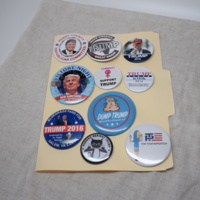
Elections and politics are a very serious matters. Sometimes too serious. Sometimes even deadly serious. Political advocacy can all too often paint bleak pictures of pessimistic current and future realities. Negative campaign advertising can take its toll on not only the candidates themselves, but the greater public as well. Any manifestation of levity or curiosity will bring a welcome respite from the more colorless and antagonistic aspects of an electoral campaign and politics at large. The items in this featured exhibit were doubtlessly intended to demonstrate the lighter side of political campaigning.
This exhibit includes Political Memorabilia that has comical and satirical value. Although many of these items may seem light hearted, they hold some underlying meanings about the poltical candidates. This includes controversies about their candidacy, as well as promotional tactics. In this exhibit you will find items like Donald Trump illustrated as excrement and Ronald Reagan as Rambo, from the pop culture film, "Rambo: First Blood." Prepare to be amused and while you are at it, check to see if we caught all of their underlying meanings!
Ossie Langfelder
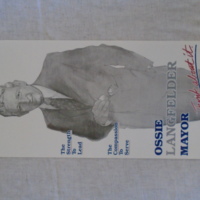
Oswald “Ossie” Langfelder (1926-2015)
Ossie Langfelder served two terms as mayor of Springfield, Illinois from 1987-1995. Langfelder, won election as the Democratic candidate in the election of 1987, as the first mayor under the current form of government. Born in 1926, the Langfelder family escaped Austria when Hitler invaded in 1938. The family moved first to the United Kingdom, before settling in the United States in 1940. Langfelder served in the US Army at the close of World War Two, as well as during the occupation of Japan. In Springfield, Langfelder worked as an engineer, before serving as Streets Commissioner and then Mayor.
This collection brings together pieces of the past, important to the service of Ossie Langfelder to Springfield, Illinois. Included in this collection are promotional materials for the campaigns, shirts, stickers as well as a pen. Also a part of this collection are scans of letters and documents related to Langfelder as well as a caricature of Ossie. During Langfelder’s first campaign for mayor in 1986 the first item of the collection was produced in order to promote key issues that Langfelder wanted to highlight. Second item in the collection is the newspaper headline from the re-election victory. After his time in office Langfelder continued to be a powerful force in Springfield politics, and he was often sought out for endorsements and photographs. The third and fourth items in the exhibit relate to Langfelder’s continued political influence in Springfield during the years after he left the mayor’s office. The final section of the exhibit collects examples of the ways that the Langfelder campaigns used material culture to connect to the public. Shirts, pins, stickers, and other items were produced by the campaigns in order to be effective connecting the candidate to the people of Springfield. Ultimately these items were effective as Langfelder won two elections for mayor.
The items in this exhibit were brought in by the Langfelder family, memories of their father and his service to the people of Springfield, Illinois.
Lincoln: The Candidate and The Icon
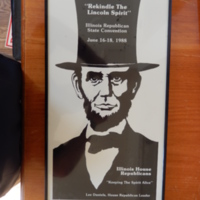
A project produced by 'Team Lincoln' in fulfilment of course requirements for History 515, "History and the Media", University of Illinois at Springfield
A Look at President Richard Nixon

Richard Nixon is one of America’s most recognizable presidents. But, unlike the other few who share this title, Nixon is often not remembered for his work as a politician. Ask anyone who Richard Nixon is and they might say, “That’s the Watergate guy, right?” While he was indeed guilty of illegal activities and deserves many of the harsh criticisms historians and the public have placed upon his legacy, Nixon ran successful campaigns for Congress and twice for President in an era when American politics and its relationship to the public was experiencing a major shift.
What surprises many, “Nixon, son of a western farmer and grocery-store owner, had struggled his way up, working through college, living sparely in a garage apartment. His story reflected the idealized ‘American Dream,’” resembling many aspects of Abraham Lincoln’s rise. Nixon sometimes referred to Lincoln in his speeches.
First serving in Congress (in both the House and the Senate), then as Vice President to Dwight D. Eisenhower, Richard Nixon had a successful career. Despite his early success, his public image began to falter starting with the first televised presidential debates during the 1960 election. Richard Nixon appeared disheveled and sweaty, his opponent John F. Kennedy was more “camera ready.” Young and energetic Kennedy defeated the experienced Nixon by a slim margin. He then unsuccessfully ran for governor of California in 1962 against incumbent Pat Brown. Finally, in 1968, amid an intensified Vietnam War, heated protests at the Democratic National Convention, and the assassination of two influential public figures (Martin Luther King Jr. and Robert F. Kennedy), Richard Nixon defeated Hubert Humphrey for president. He ran for reelection in 1972 defeating opponent Georger McGovern in a landslide. Unfortunately, shortly after his election, the Nixon administration began cover-ups for the break in at the DNC headquarters in Washington D.C. In 1974, after an FBI investigation and an intense court battle, Richard Nixon resigned the presidency.
Richard Nixon is a nuanced figure in American history who, like the Founding Fathers and those assassinated shortly after reelection, is reduced to a one-dimensional figure (although Nixon is remembered for his faults rather than his successes). By focusing on his initial campaign and his bid for reelection, we look beyond the scandal-doer and highlight a few distinct aspects of the work and successful campaigns of the 37th president, Richard M. Nixon.
A sample ballot for the 1968 election marks the starting point of the exhibit and gives a general background to the time. We then turn local, showcasing a photograph of Richard Nixon in Springfield. The posters - for the 1972 election and "Coolness" - and the button collection serve to highlight issues that have always haunted Nixon: The public's views on his person and a slightly paranoid handling of the press. The "War on Drugs"-pamphlet retells one aspect of Nixon's politics that would prove very long-lasting. We conclude the exhibit with a look at the eventually unfortunate duo "Nixon/Agnew", as neither of them end up leaving office gracefully.
Draped in Ideology: Clothing and Politics
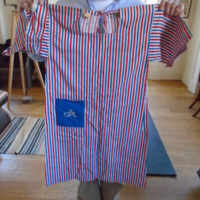
American citizens have a long history of joining the fashionable and the political in order to convey ideologies to those around them. Today it is a common occurrence, especially during elections, to see individuals wearing campaign shirts, hats, or buttons. The five items in this exhibit are examples of how citizens promote their candidates during elections, local and national. Wearing these items may seem like a recent concept, but Americans have been using clothing to convey their personal beliefs since colonization. In the decades, leading up to the American Revolution fashion became simplified, not just out of necessity, but also as a social commentary on the changing ideals of independence and equality.Patriots embraced these changes in clothing by promoting homespun, local fabrics as a way to maintain autonomy from foreign manufacturing and in essence, the monarchy.
The history of campaign paraphernalia goes back to George Washington, when sew-on-buttons were manufactured to commemorate his 1789 inauguration. The election between Andrew Jackson and John Quincy Adams in 1828, forty years after Washington’s buttons, is hailed as the first presidential election where both men appealed to citizens on a national level. Jackson’s strategy was to hold events and give out campaign trinkets such as medals and snuffboxes. This tradition continued and only gained popularity among politicians and citizens in all levels of government, which can be seen in the wide array of political clothing within this exhibit.
Wearing campaign material is a way to endorse a particular candidate as well as displaying membership to certain communities, which can be advantageous for politicians when they want to promote their own social inclusivity. This is most apparent when politicians pander to certain demographics, as evident with the LGBT themed shirt in this exhibit, which features the Bernie Sanders logo in the recognizable LGBT rainbow, sold during his 2016 presidential campaign. Building communities are most evident in local elections, where clothing is given out to residents of districts and cities. In smaller communities wearing politicized clothing has even more power because there are often personal relationships with the candidate as seen with the Springfield, Illinois specific Langfelder Family items as well as the jacket worn by Mrs. Hunter during her husband’s 1978 campaign for the U.S. House of Representatives.
The act of providing campaign items has become a lucrative trade during elections. Not only are politicians able to market their candidacy by creating logos and catch phrases but by wearing these items citizens show their allegiance as well as promote their candidate. With the expansion of online shopping, Presidential candidates have been able to benefit from selling their own trinkets, usually returning the income to their campaign funds. This was pioneered by Barack Obama’s campaign, with the sale of merchandise earning the President’s 2012 bid for re-election, 40 million dollars.
Clothing as a means of political expression is such a powerful tool in America that in 1992 the Supreme Court ruled that allowing election merchandise to be worn at polling places was a means of voter influence. Citizen’s sartorial choices will always be an important aspect of elections and society. Even without candidate specific apparel, the “I Voted” stickers provided at polling places are enough to politicize any outfit, proving to others the fulfillment of one’s civic duty.
Illinois Mass Media
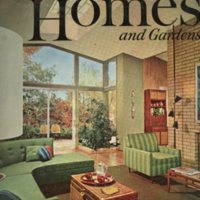
Before the internet, the media relied on physical pieces of paper to reach its audience. These bits of paper would wind up in people’s homes and sometimes into people’s archives. And without digital records, it wasn’t possible to keep everything. Only the most important stories could hope to be preserved.
Find out what stories visitors to our harvest felt warranted preserving a physical copy, long after they became “history” rather than “news.”
African-American History in Illinois

African-American history in Illinois has been similar to the rest of the country; challenging and difficult with many roadblocks along the path to equality. What makes it unique here is Illinois' unique position between the North and the South and its relationship between its rural and urban citizens. One cannot estimate how far African-American rights have come in Illinois without looking at the extreme difficulties they have faced.
Nowhere in Illinois has this been more obvious than with the 1908 Springfield Race Riot. African-American homes and businesses were burned and destroyed causing many to leave Central Illinois. The African-Americans who remained there persisted through this difficult time, even 50 years later when racial tensions were high in the South over the Montgomery Bus Boycotts. A reprint of an article from Alabama in the Decatur Newspaper certainly shows how widespread the issue was.
The Springfield Race riot, bus boycott and the story of Marshal Robert Moore present an enduring African American struggle for advancement. Racism and ethnic prejudice are significant problems in our society as they are troubling and potentially catastrophic. In most cases, peaceful protest and violence occurred to break free from racist mentality. Out of the race riot at Springfield had come the organization of the first effective black protest. The N.A.A.C.P focused the national attention on these incidents, points the finger of scorn, and bring the black discontent to the open.
Finally, one can see how far African-American rights have come in Illinois with a great example of Robert Moore. Examining these issues is essential in order to ensure we do not repeat the mistakes of the past.
Sports and Recreation in Illinois
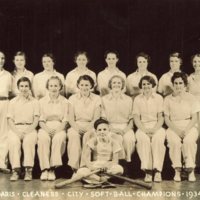
If you, root, root, root for the Cubbies, watch the Chicago Bears play on a Sunday afternoon, cheer on the Fighting Illini, or watch the Blackhawks dominate, you may be a true blooded Illinoisan. Sports and recreation are a big part of who we are as natives. Families come together to spend time with one another while enjoying a game or attending a school event. Like many states, our roots lie in our native sports stadiums, because that is where we watched our heroes defy the odds, break records, and follow their dreams.
This exhibit includes small-town and professional sports teams and memorabilia. While also including high school and small-town recreation. These items all tell a story, they all have a past, and they hold great importance to Illinois history.
Illinoisans at War
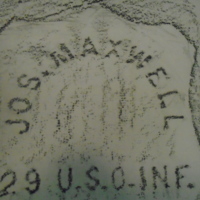
Military conflict has been ingrained in the United States since its inception in 1776. Throughout the years countless individuals from Illinois have answered the call of conflict. Being recognized by one’s service to the nation and being bestowed the title of Veteran is an honor that few people can claim. A debt is owed to all veterans and the State Of Illinois continuously acknowledges the sacrifices made by those individuals who have served. Illinois veterans have participated in every major national conflict dating back to the Civil War. The history harvest has allowed an opportunity for community members to bring in veteran memorabilia in an attempt to share these individuals legacies. The pieces presented are an extension of those individuals and their time in service. Also highlighted through these items are some of the programs that have existed as benefits to those who earn the title veteran. Below is a brief explanation of the history of veteran benefits and what services are provided for veterans.
The United States has the most comprehensive system of Veterans benefits and care of any nation in the world. This history of Veterans’ benefits in this country dates from the War for Independence. For the first few years Veterans’ benefits were handled by the Federal Courts, but this quickly proved to be unsatisfactory and responsibility for administering benefits was assigned to the War Department. Initially, no clear distinctions were made between service pensions, pensions for needy, aged, or disabled Veterans, and pensions based on disabilities arising from military service. Different pension programs with different eligibility requirements were enacted for Veterans of each of the wars the United States fought during the first half of the nineteenth century. Benefits for survivors of wartime Veterans were first authorized about 1806. Until 1930 responsibility for various Veterans’ programs was fragmented among several agencies. During the latter part of the 1800s and the early 1900s, a Bureau of Pension administered Veterans’ pension programs; at different times this Bureau was variously under the jurisdiction of the War Department, the Navy Department, the Treasury Department, and the Interior Department. In 1914 a Bureau of War Risk Insurance was established under the Treasury Department to ensure American ships and cargoes against the hazards of carrying war materials to the Allies. When the United States formally entered World War I in 1917, the Bureau of War Risk Insurance was assigned the additional tasks of providing life insurance for American troops and administering Veterans’ and survivors’ benefits after the war. In 1918 a Federal Board of Vocational Education was established as an independent agency to provide vocational rehabilitation for disabled World War I Veterans based on eligibility as determined by the Bureau of War Risk Insurance. The Public Health Service was charged with responsibility for providing medical care for World War I Veterans. In 1921 the Veterans Bureau was established as an independent agency to consolidate all benefits for World War I Veterans (life insurance, disability and death compensation, vocational rehabilitation, medical care) under one agency. The Bureau of Pensions continued to separately exist to handle benefits for Veterans of previous wars and their survivors. The Veterans Administration was established in 1930, merging the Veterans Bureau and the Bureau of Pensions and finally bringing all Veterans’ benefits programs under the jurisdiction of a single agency.
Following World War II, the Veterans Administration grew to become the largest non-Cabinet agency in the Federal Government. On March 15, 1989, the Veterans Administration became a Cabinet-level agency, changing its name to the U.S. Department of Veterans Affairs. The Administrator of Veterans Affairs became the Secretary of Veterans Affairs. The new agency was composed of three primary sub-agencies, each headed by an Undersecretary: the Veterans Benefits Administration (VBA); the Veterans Health Administration (VHA); and the National Cemetery Administration, plus a number of subsidiary offices and Secretariats, including the Board of Veterans’ Appeals, the Office of General Counsel, and the Office of the Inspector General.
VETERANS BENEFITS ADMINISTRATION (VBA) VBA administers all of the non-medical benefits programs for Veterans, dependents and survivors: the compensation and pension programs; vocational rehabilitation for disabled Veterans; various education and training assistance programs for Veterans, dependents and survivors; loan guaranty programs for Veterans and eligible surviving spouses; and a number of life insurance programs for Veterans. VBA also provides a burial allowance for eligible Veterans.
VETERANS HEALTH ADMINISTRATION (VHA) The Veterans Health Administration is home to the largest integrated health care system consisting of 153 medical centers, in addition to numerous community based outpatient clinics, community living centers, Vet Centers and Dormitories and Nursing Homes. Together these health care facilities provide comprehensive care to over 5.5 million* Veterans each year. VHA Medical Centers provide a wide range of services including traditional hospital-based services such as surgery, critical care, mental health, orthopedics, pharmacy, radiology and physical therapy. In addition, most of the medical centers offer additional medical and surgical specialty services including audiology & speech pathology, dermatology, dental, geriatrics, neurology, oncology, podiatry, prosthetics, urology, and vision care. Some medical centers also offer advanced services such as organ transplants and plastic surgery.
NATIONAL CEMETERY ADMINISTRATION (NCA) The National Cemetery Administration Honors Veterans with final resting places in national shrines and with lasting tributes that commemorate their service to our nation. NCA provides burial space for Veterans and their eligible family members. They maintain national cemeteries as national shrines, sacred to the honor and memory of those interred or memorialized there. NCA is also responsible for marking Veterans’ graves with a government-furnished headstone or marker and to provide Presidential Memorial Certificates in recognition of their service to a grateful nation. Finally, NCA is responsible for administering grants for establishing or expanding state Veterans’ cemeteries.
A Special Thanks to:
-
The National Museum of the United States Army
-
The National WWII Museum
-
Illinois Department of Veteran Affairs VSO Handbook
Lithuanians in Illinois: A New Life
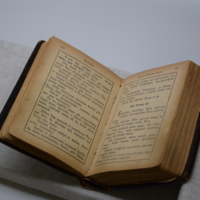
The late 19th century saw the first major wave of Lithuanians into America. Thousands of Lithuanian people came to the Springfield Illinois area. Lithuanians fled harsh repression experienced under the Russian Empire. Lithuanians in Russia suffered poverty, conscription, and a ban on their language. At first Lithuanian men came to Sangamon county to work in the coal mines. After the men found work, the rest of the family would come over the Atlantic ocean to join them. These Lithuanian families formed their own community in Springfield. This community, united in their faith as well as their language and history, built the Saint Vincent de Paul Catholic Church in 1909.
This collection of items brings together a rich history of the Lithuanian families that lived in the Springfield area during the 19th and 20th centuries. Please enjoy these artifacts and the history connected to them. Included in this collection, we will explore the photos of Lithuanian families, pictures of the old Saint Vincent de Paul Catholic Church, and scans of select documents. The journey of this collection will help us better understand the Lithuanian history in the Springfield Illinois area.
